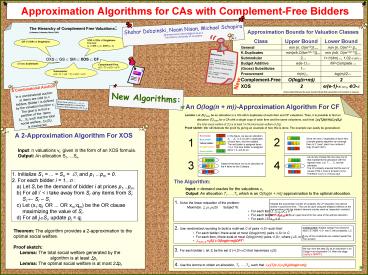Approximation Algorithms for CAs with ComplementFree Bidders - PowerPoint PPT Presentation
1 / 1
Title:
Approximation Algorithms for CAs with ComplementFree Bidders
Description:
Approximation Algorithms for CAs with Complement-Free Bidders. e/(e-1)-e (NP), 4/3-e ... Proof sketch: We will illustrate the proof by giving an example of how ... – PowerPoint PPT presentation
Number of Views:19
Avg rating:3.0/5.0
Title: Approximation Algorithms for CAs with ComplementFree Bidders
1
Approximation Algorithms for CAs with
Complement-Free Bidders
The Hierarchy of Complement Free
Valuations (Lehmann, Lehmann, Nisan, 2001)
Shahar Dobzinski, Noam Nisan, Michael
Schapirashahard,noam,mikesch_at_cs.huji.ac.ilThe
Hebrew University of Jerusalem
Approximation Bounds for Valuation Classes
XOR of ORs of Singletons. Example (x12 OR x22)
XOR (x13)
OR of XORs of Singletons.
(LOS)
(NS)
(DNS)
(BGN)
OXS ? GS ? SM ? XOS ? CF
(NS)
(new)
(LLN)
(Gross) Substitutes
Complement-Free v(S?T) v(S) v(T)
(LLN)
(AM)
Submodular v(S?T) v(S??T) v(S) v(T)
(NS)
(NS)
(NS)
New
A Combinatorial Auction In a combinatorial
auction m items are sold to n bidders. Bidder i
is defined by the valuation function vi. The
goal is to find a partition of the items S1Sn
such that the total social welfare, Sivi(Si), is
maximized.
New Algorithms
Unless stated otherwise the lower bounds indicate
that exponential communication is required.
Given items prices, p1,,pm, a demand oracle for
v returns the bundle S that maximizes
v(S)-Sj?Spj.
An O(log(n m))-Approximation Algorithm For CF
Lemma Let Si1in be an allocation in a CA
with k duplicates of each item and CF valuations.
Then, it is possible to find an allocation
Ti1in for a CA with a single copy of each
item and the same valuations, such that
Sivi(Ti)(1/k)(Sivi(Si)) (the total social
welfare of Ti is at least 1/k the total social
welfare of Si). Proof sketch We will
illustrate the proof by giving an example of how
this is done. The example can easily be
generalized.
A 2-Approximation Algorithm For XOS
2
1
Input n valuations vi, given in the form of an
XOS formula. Output An allocation S1,...,Sn.
3
4
- Initialize S1 ... Sn ??, and p1 ...pm 0.
- For each bidder i 1...n
- Let Si be the demand of bidder i at prices
p1...pm. - For all i lt i take away from Si any items from
Si - Si ? Si Si
- Let (x1q1 OR ... OR xmqm) be the OR clause
- maximizing the value of Si.
- For all j?Si, update pj qj.
The Algorithm
Input n demand oracles for the valuations vi.
Output An allocation T1 ,...,Tn which is an
O(log(n m)) approximation to the optimal
allocation.
- 2. Use randomized rounding to build a multiset C
of pairs lti,Sgt such that - For each bidder i there exist at most
O(log(nm)) pairs lti,Sgt in C. - For each item j there exist at most O(log(nm))
pairs lti,Sgt, where j?S, in C. - Slti,Sgt?C vi(S) O(log(nm))OPT.
Construction Repeat O(log(nm)) times for each
i,S insert lti,Sgt into C with probability
xi,S. If any of the constraints are violated
repeat this from scratch.
Theorem The algorithm provides a 2approximation
to the optimal social welfare. Proof sketch
Lemma The total social welfare generated by the
algorithm is at least Spi. Lemma The
optimal social welfare is at most 2Spi.
3. For each bidder i, let Si be the set S
(lti,Sgt?C) that maximizes vi(S).
We can view the sets Si as an allocation in an
O(log(nm))-duplicates CA. After this
stage Sivi(Si) O(OPT).
4. Use the lemma to obtain an allocation, T1,
,Tn, such that Sivi(Ti) (Sivi(Si))/(log(nm)).































